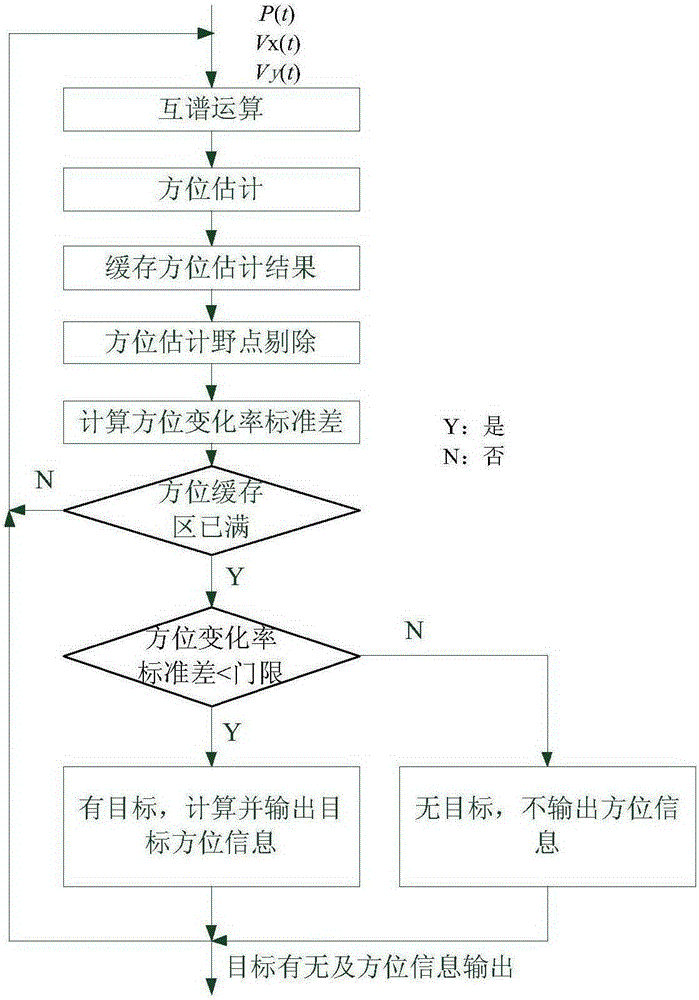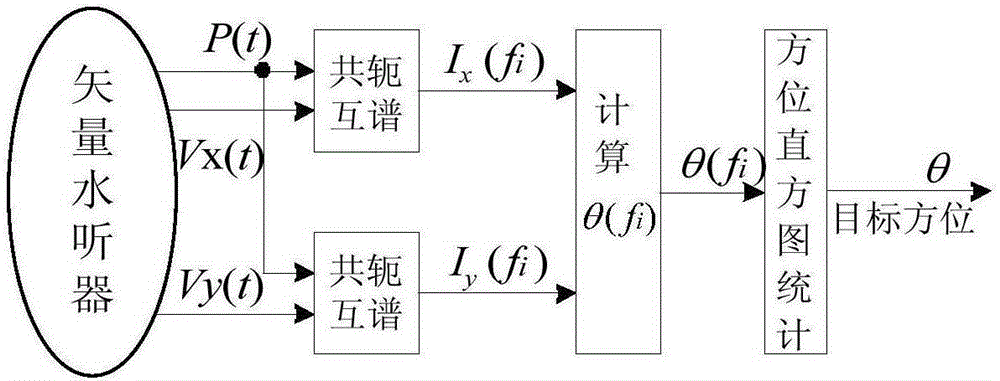Continuous spectrum signal target automatic detection method based on single vector subsurface buoy
An automatic detection and continuum technology, applied in measuring devices, sound wave re-radiation, radio wave measurement systems, etc., can solve the problems of difficult determination of detection threshold and susceptibility to interference
- Summary
- Abstract
- Description
- Claims
- Application Information
AI Technical Summary
Problems solved by technology
Method used
Image
Examples
specific Embodiment approach 1
[0038] Specific implementation mode 1: A method for realizing automatic detection of a continuum signal target based on a single-vector latent target in this embodiment is implemented in the following steps:
[0039] 1. Take the vector hydrophone sound pressure channel signal P(t), the x-axis vibration velocity Vx(t) and the y-axis vibration velocity Vy(t), respectively divide P(t) and Vx(t), P(t) Perform cross-spectrum calculation with Vy(t) to obtain the sound intensity flow spectrum I of the sound pressure channel signal P(t) and the x-axis vibration velocity Vx(t) and y-axis vibration velocity Vy(t) x (f) and I y (f), according to the sound intensity flow spectrum I x (f) and I y (f) Obtain the horizontal azimuth angle estimation result θ(f) of each frequency;
[0040] 2. Use the cross-spectrum histogram statistical method to estimate the continuum target azimuth, and obtain the current continuum signal target azimuth information θ 0 (n), and the continuum signal targe...
specific Embodiment approach 2
[0059] Specific embodiment two: the difference between this embodiment and specific embodiment one is: the method described in step one gives the horizontal azimuth angle estimation result θ(f) of each frequency according to the sound intensity flow spectrum, specifically:
[0060] (1) The sound pressure channel signal P(t) and the x-axis vibration velocity channel signal Vx(t) and the y-axis vibration velocity channel signal Vy(t) perform cross-spectrum calculations to obtain two cross-spectrum outputs Its calculation formula is:
[0061] S P V x ( f ) = P ( f ...
specific Embodiment approach 3
[0068] 3. Specific implementation mode three: the difference between this implementation mode and specific implementation mode one or two is that step two is specifically:
[0069] (1) From formula (3), it can be seen that the orientation estimated by the cross-spectrum operation is related to the frequency f, so for each frequency point f i The expression for orientation estimation is written as:
[0070] θ ( f i ) = tg - 1 I y ( f i ) I x ( f i ) - - ...
PUM
 Login to View More
Login to View More Abstract
Description
Claims
Application Information
 Login to View More
Login to View More - R&D
- Intellectual Property
- Life Sciences
- Materials
- Tech Scout
- Unparalleled Data Quality
- Higher Quality Content
- 60% Fewer Hallucinations
Browse by: Latest US Patents, China's latest patents, Technical Efficacy Thesaurus, Application Domain, Technology Topic, Popular Technical Reports.
© 2025 PatSnap. All rights reserved.Legal|Privacy policy|Modern Slavery Act Transparency Statement|Sitemap|About US| Contact US: help@patsnap.com



